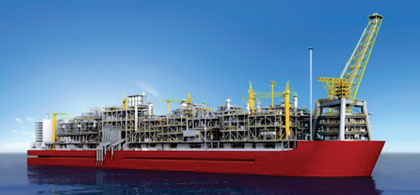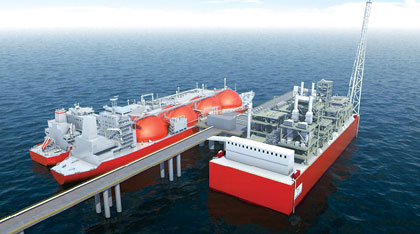LNG technology
S. Mokhatab, Gas Processing Consultant, Canada
As global demand for natural gas increases, interest in unlocking and monetizing stranded gas reserves in ultra-deep waters that are difficult to develop with conventional technology will return. This makes floating liquefied natural gas (FLNG) a technically innovative solution for liquefying natural gas and a commercially viable means of exploiting remote offshore gas reserves, while at the same time providing an economically preferable option to flaring associated gas.1
FLNG production technology may offer lower production costs, reduced time to first production, improved environmental performance and potentially increased security of facilities. In addition, a potential advantage of a floating facility is that it can be remobilized easily to a new location once the original gas resources decline or if economics change. This allows the operator to save money on future gas field developments and gain revenues by charging third parties to process their gas through the FLNG facility.
While principally aimed at remote offshore gas reserves, FLNG production technology can be considered for the development of nearshore gas fields with limited infrastructure. Alternatively, FLNG can be used to liquefy pretreated onshore pipeline-quality gas for export to markets that require small to midscale LNG supply volumes. It may also be used where the shoreline is too rugged and difficult to build infrastructure like LNG tanks (e.g., Western Canada).
The two FLNG development schemes are not comparable in terms of complexity and cost. Offshore FLNG production offers a potential solution for many projects, in particular small to midscale capacity (0.5 MMtpy to 3 MMtpy). Although the FLNG production concept has been the focus of research and development since the 1980s, it is only in the last 10 years that a few FLNG projects (Shell’s Prelude FLNG and Petronas’ FLNG 1 and FLNG 2) have progressed to detailed design and construction. In fact, some special challenges exist in the design, construction and operation of an FLNG facility in the harsh offshore environment (e.g., limited deck space, higher inherent process safety requirements, equipment weight and size limitations, equipment marinization, frequent startups and shutdowns due to ocean-induced vessel motions and more feedstock variations) that requires capital-intensive mitigating designs.
The existing technical challenges associated with offshore FLNG technology show that the nearshore FLNG concept (utilizing a barge-type LNG floater in shallow waters and anchored off the coast or moored at shore) can be competitive. The nearshore barge design and operations are considerably simpler, safer, faster, more flexible and less expensive than a deep offshore FLNG facility that must be built to withstand rough seas.
 |
|
Fig. 1. Digital rendering of a typical offshore FLNG facility.2 |
This concept can also provide a smaller footprint and lighter weight for the floating facility, both of which are valuable in the FLNG market. In fact, the FLNG production facility can be self-sufficient, including fully integrated gas processing facilities as well as utility systems (Fig. 1), making it well suited for developing both offshore and nearshore gas fields (without any existing gas processing infrastructure).
 |
|
Fig. 2. Digital rendering of a typical nearshore FLNG facility.3 |
Alternatively, it can utilize systems (including reception facilities, gas processing units, condensate storage tanks and electrical generation) located onshore at dockside with a short transportation gas pipeline to bring pipeline-quality gas to the host barge for further processing and then liquefaction for export (Fig. 2). This option reduces both the weight and footprint of the FLNG facility and provides significant cost savings and an accelerated project development schedule, with the potential for standardization. Several other advantages include:
- Better economic advantages than a deep offshore FLNG facility, with greater likelihood of being able to extract NGL economically onshore.
- No need to install the expensive turret mooring system for the FLNG facility, as it is either spread moored or moored to a jetty
- Reduced motion dynamics for the FLNG facility, as it would be placed nearshore with calm and stable weather conditions. It can also be placed on a large, concrete, gravity-based structure (GBS), which is a stable and robust platform for installation. This can improve production uptime and result in easier LNG transfer conditions.
- Much simpler than offshore FLNG regarding operation and maintenance, reducing the number of personnel on board. The lower risk of operating small to midscale FLNG facilities on nearshore sheltered waters provides access to more project financing options.
- Minimum requirements of onboard gas pretreatment, leading to a choice among a wide range of simple, compact and cost-efficient gas treating options suitable for floating applications. In some cases, this can also potentially reduce the energy requirements in the liquefaction section.
- Lowered risk of sloshing in membrane-type containment systems, resulting in the utilization of more storage capacity inside the LNG tank.
- Increased opportunities for alternative utility systems. For example, a combined-cycle power plant can be installed onshore to produce power and steam to support the FLNG facility.
- Improved safety due to lower inventory of hazardous gas treating chemicals and catalysts. In the meantime, flare(s) can be located onshore at a safe distance from the liquefaction facility with no space limitation.
- Easier logistics to support FLNG facility operations and maintenance, resulting in minimized downtime.
Although nearshore FLNG technology is less costly than offshore FLNG production, with today’s low energy prices, even nearshore FLNG projects must be proven to be economically viable. However, for countries that wish to have LNG exports and plenty of gas resources, the investment may be justified.
In recent years, a movement has been seen to build FLNG production facilities nearshore. For example, Golar’s first nearshore FLNG facility (GoFLNG), with a production capacity of 1.2 MMtpy, is being developed to receive feed gas from the offshore Kribi (Cameroon) fields, and is expected to come onstream in 2Q 2017. FLEX’s nearshore FLNG facility, with a production capacity of 1.7 MMtpy, will be moored alongside a jetty and liquefy gas from the onshore Elk and Antelope gas fields in Papua New Guinea. It is expected to commence operations in 2018.
Delfin LNG is developing a nearshore FLNG project at Port Delfin, which is approximately 50 mi off the coastline of Cameron Parish in Louisiana. This project, which will receive natural gas from the Delfin Offshore Pipeline and include four FLNG facilities with an initial total export capacity of 8 MMtpy, is expected to be fully operational by 2019.
Eni’s planned, 2.5-MMtpy nearshore FLNG project for the development of the Coral gas field in the Rovuma basin offshore Mozambique, for which a development plan was submitted to local authorities at the end of 2014, has yet to be approved because there is disagreement over how the project should be structured—i.e., on an integrated basis or as a non-integrated model. However, state oil company ENH is confident that the project can keep to the original timetable of production startup in 2019.
A key step in the development of an attractive nearshore FLNG project is the selection of an appropriate gas pretreatment system and liquefaction process cycle that best meet the project objectives. Several technology options can be integrated into the design of the gas pretreatment section. When determining the optimal integrated pretreatment scheme, safety, weight, cost, reliability and operational flexibility must be considered. A successful nearshore FLNG project also requires the application of a proven liquefaction technology that is safe, simple (with minimum level of maintenance requirements), easy to operate, flexible for variation in gas composition and turndown, scalable, space-efficient, fast-track and cost-efficient. The investment in a high-quality engineering consultant to provide the process selection study will be rewarded with a reliable, fit-for-purpose and cost-effective nearshore FLNG solution. GP
References
1Mokhatab, S. et al., Handbook of Liquefied Natural Gas, Gulf Professional Publishing, Burlington, Massachusetts, 2014.
2Miller, C., “New FLNG vessels present challenges in building, automation,” Offshore Magazine, Vol. 75, Iss. 6, June 2015.
3Criscione, V., “New opportunities for floating LNG production,” The Norwegian Trade Portal (Nortrade), Oslo, Norway, January 24, 2014.
 |
Saeid Mokhatab is an internationally recognized gas processing consultant who has been actively involved in several large-scale gas field development projects, concentrating on design, precommissioning and startup of processing plants. He has presented on gas processing technologies worldwide and has authored or coauthored nearly 250 technical publications, including two well-known handbooks. Mr. Mokhatab has held technical advisory positions for leading professional journals, societies and conferences in the field of gas processing, and has received a number of international awards in recognition of his outstanding work in the natural gas industry.




Comments